About a year ago, I posted the first series of screenshots from a film that had come my way years ago. A Zephyr reader mailed me a homemade DVD. On it was a very rough copy of a silent 16mm film —a travelog of sorts— shot in 1949 by Ray Garner and his wife Virginia. I grabbed a few screenshots and clips from that DVD and I believe you can even find those clips on The Zephyr facebook page. But again the quality was poor and even distorted—- the image was stretched when it was digitized.
Then last year, by accident, I found the film in its entirety on the internet. It had been donated to the National Archives and though the film quality still pales by today’s standards, it is the history in these films and images that I love, more than the film quality itself. Ray and Virginia Garner started making films in the late 1930s. Ray’s first known project was a film about ascending the Grand Teton with a group of Boy Scouts in 1936. Sadly the film has been lost. But it was the beginning of an independent filmmaker career and soon, a wonderful collaboration with his new wife Virginia. Though the title of the film I’m offering here gives credit to Ray, Virginia, or “Jinny” as she was known to everyone, was not only his equal in the filming, production and presentation of what were often silent films, she was certainly more photogenic and appears often in them. That’s’ what gives these 16mm movies such a personal feel. As I understand the story, they toured the country with their movies and at various gatherings, they would narrate the film in person as it was being shown.
Ray and Virginia came to Southeast Utah in May 1949. They spent the summer wandering the Four Corners, from what was then a very empty Arches National Monument, to the Needles, more than 15 years before it would become a part of the new Canyonlands National Park. Later they traveled south through Tuba City and scaled Agathla Peak on the Navajo Reservation and even drifted as far south as Sedona.
I have pulled dozens of screenshots from the film and tried to restore them as much as possible. And at the bottom of this page and in further installments, I’ll include the link to the Garners’ one hour motion picture in its entirety. Keep in mind, it’s a silent film.
In 1949, Bates Wilson had just come to Arches National Monument as its first superintendent, and was immediately drawn to the vast landscape to the west. The idea of making those tens of thousand of square miles of canyon country a national monument as well. Interior Secretary Harold Ickes loved the idea but local and state opposition delayed the issue for 30 years.
Ray was born in 1913 and died in 1989. Virginia came along in 1915. She met and married Ray in 1938; it was the start of a 50 year partnership that took them all over the world, from canyon country to Egypt and to equatorial Africa. They were not wealthy by any means. but they were lucky to have caught the attention of the Harmon Foundation. The non-profit organization created to support the arts and history was the brainstorm of former Alaska Governor William Harmon. The governor was fairly prosperous and the Harmon Foundation was his legacy. He, in fact, died in 1928, before he ever saw the work of the Garners. But his generosity and support of projects like theirs is a tribute to the governor and his vision; the Garners were grateful to him and to the foundation for decades.
According to Virginia Garner’s obituary, she and Ray even “made a film on learning to fly at the U.S. Army air base at Tuskegee, Alabama. Here, they were taught to fly by members of the famed African-American combat unit which came to be known as the Tuskegee Airmen. In a rare tribute, ‘Jinny’ was made an honorary Tuskegee airman.” She died in 2007.
NOW TO THE NEEDLES…1949
Here is the second installment of still images (and a link to the film) “The Desert— Exploring the Southwest”… It is devoted to their time in that wild part of the canyon country called The Needles, and which became part of Congressionally mandated “Canyonlands National Park” in 1964. But the Garners had some help, as is evident in these images; sixty years later, one of those “eyewitnesses” is still here to offer his memories of those days.
He’s Alan “Tug” Wilson, Bates Wilson’s son, and though it’s been decades since his dad let Tug work as a trail guide at age 14, he still has vivid memories of the Garners and a film crew from National Geographic which would feature Jack Breed’s feature “Roaming the West’s Four Corners.


I have never known The Needles backcountry as well as I wanted. By the late 1970s, the road to NPS district headquarters was paved, and over the last 50 years, visitation has increased dramatically, though then-controversial efforts by the NPS to limit “development” of the Needles have kept it from becoming a “windshield park” like so many other parks in the West. But in the early 70s, this country was almost as quiet as it had been with the Garners. Rangers were few and far between, and I was usually able to sneak my dog Muckluk onto the trail with me. We covered a lot of ground on foot, between 1973 and 1977.
Once Muck and I were able to catch a ride with two seasonal ranger pals, in the days when we could still run vehicles to Angel Arch. At the time, we never saw another car, but over the next decade, traffic increased and restrictions were placed on backcountry 4WD travel. Ultimately Salt Creek was closed to all vehicular traffic.
Still, my knowledge of the geography is relatively limited, so I turned to Tug for his assistance and advice. I sent Tug most of these screenshots and he was able to fill in the blanks for me. I’ve had some great email exchanges with Tug since we were first in touch, and I’m looking forward to posting some of his most vivid memories and photographs from his time in Southeast Utah…Something I really look forward to…
Jim Stiles
NOTE: You’ll notice that the quality of these images is not the best, but their historical value is priceless. The original 16mm film was badly degraded by the time anyone thought to digitize it. Still, despite the grainy, slightly blurred images, and those vertical scratches, I could look at these pictures all day. When you reach the end of the still images, note that there is a link to the film itself. There’s no sound, so do your own narration. But these images are worth thousands of words, coming as they do, from another time…Enjoy the ride…


LANDING A CESSNA IN CHESLER PARK w/ PUGH STOCKS


“Jinny my Love…Come to landing site in meadow…4 steaks…(I can’t make out the next part..then) Incidentally me. PS. Got film..Is Ray treating you all right…Tis me.“



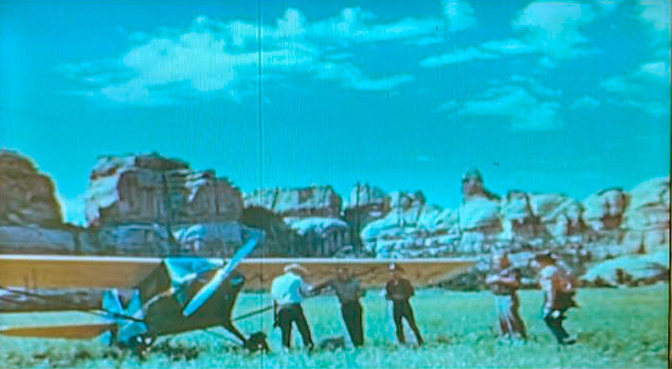


AN EARLY EFFORT TO IDENTIFY & PROTECT ARCHAEOLOGICAL TREASURES IN THE CANYON COUNTRY





TOO MUCH WATER…AND QUICKSAND!


…OR ELSE THERE’S NOT ENOUGH WATER.



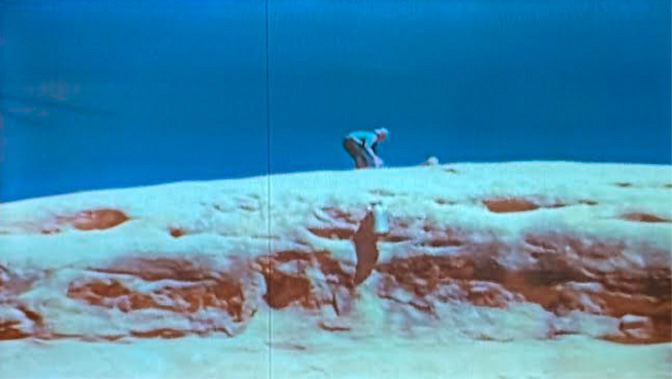

AND WHEN THE WATER COLLECTING IS DONE, IT’S TIME TO ROLL ONE.


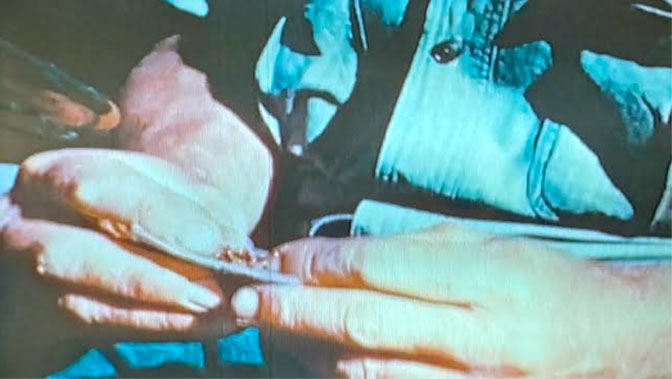
Camping in Chesler Park


To watch Ray and Virginia Garner’s 16 mm silent film, use this URL…Some are having trouble. I just tried to us this link and it works for me..

RAY AND VIRGINIA GARNER

Ray was born in 1913 and died in 1989. Virginia came along in 1915. She met and married Ray in 1938; it was the start of a 50 year partnership that took them all over the world, from canyon country to Egypt and to equatorial Africa. They were not wealthy by any means. but they were lucky to have caught the attention of the Harmon Foundation. The non-profit organization created to support the arts and history was the brainstorm of former Alaska Governor William Harmon. The governor was fairly prosperous and the Harmon Foundation was his legacy. He, in fact, died in 1928, before he ever saw the work of the Garners. But his generosity and support of projects like theirs is a tribute to the governor and his vision; the Garners were grateful to him and to the foundation for decades.

According to Virginia Garner’s obituary, she and Ray even “made a film on learning to fly at the U.S. Army air base at Tuskegee, Alabama. Here, they were taught to fly by members of the famed African-American combat unit which came to be known as the Tuskegee Airmen. In a rare tribute, ‘Jinny’ was made an honorary Tuskegee airman.” She died in 2007.
To see Part One of this series of still shots in The Zephyr about the Garners’ 1949 visit to Arches National Monument, click here.
TO COMMENT ON THIS STORY, PLEASE SCROLL TO THE VERY BOTTOM OF THIS PAGE.



And I encourage you to “like” & “share” individual posts.
Why they can’t just leave the site alone is beyond me,
but that’s what Facebook likes to do.
ALSO NOTE: I post old photographs and stories from our 25 year old archives every day. Pictures from Herb Ringer, Edna Fridley, Charles Kreischer.. even a few old photos from my Dad. So if you want to stay caught up on our historic photo collections,
be sure to “follow” us on Facebook…Thanks…Jim
https://www.facebook.com/FansoftheCanyonCountryZephyr/


Signed copies

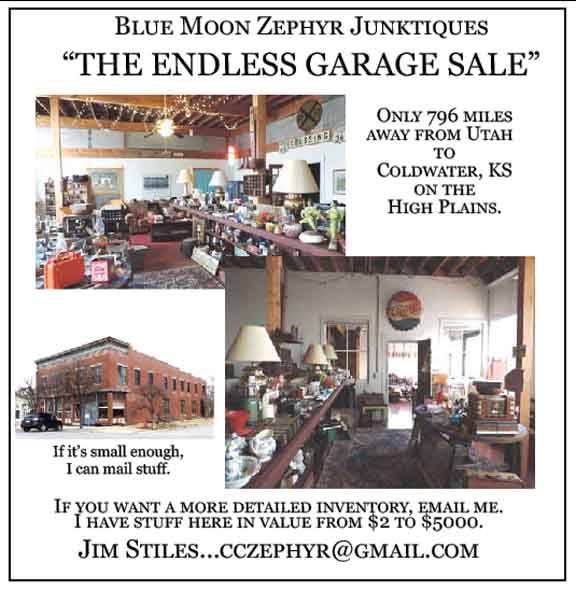
https://www.facebook.com/profile.php?id=100086441524150



And check out this post about Mazza & our friend Ali Sabbah,
and the greatest of culinary honors:
https://www.saltlakemagazine.com/mazza-salt-lake-city/
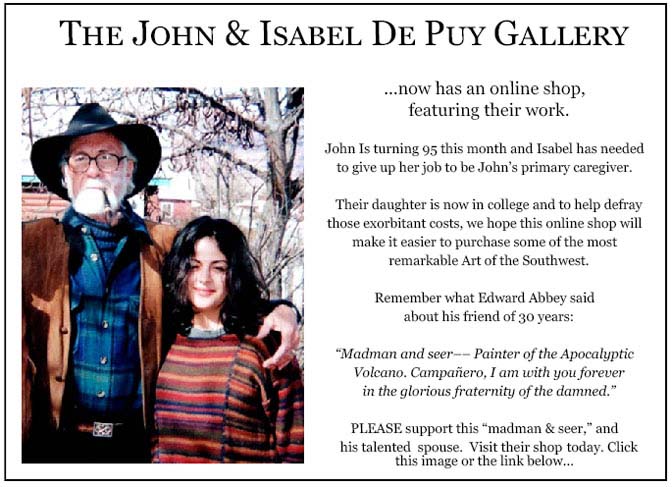
More than six years ago, The Zephyr, me & four other individuals were sued for defamation by the former Moab City Manager. Faced with mounting legal bills, my dear friends John and Isabel De Puy donated one of John’s paintings to be auctioned.
ALL the proceeds went to our defense.
Thanks to them, our bills were almost completely covered.
Now I’d like to return the favor. Check out the link below and their online shop… JS
https://www.depuygallery.com/

https://www.canyoncountryzephyr.com/
AND AGAIN…IF YOU’D LIKE TO COMMENT ON THIS POST, AND ESPECIALLY IF I HAVE MIS-IDENTIFIED A LANDMARK AND YOU CAN PROVIDE A MORE ACCURATE DESCRIPTION, I WELCOME YOUR INPUT…THANKS/JS



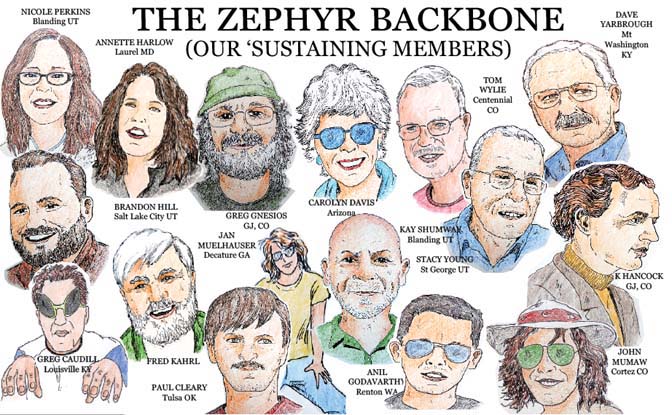





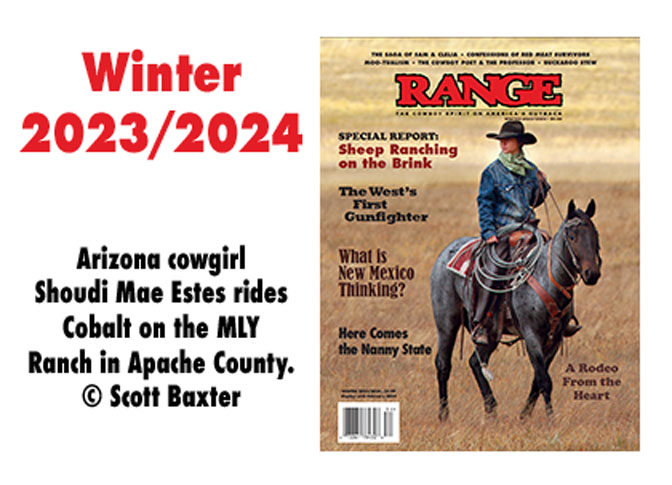
Very interesting~It brought back lots of memories of explorations long before they were publicized and overwhelmed by tourists. Two of my aunts rolled their own cigarettes–until the fad began somewhere in the thirties that the cellophine around cigarette packages could be woven into belts. The they bought their cigarettes and braided the cellophine into belts. I even watched the 16mm. film and marveled that it was still in pretty good condition and still saved! Your efforts to introduce these old pictures to a modern world are heroic! Thank you!
Great stills and story but I really wanted to see the whole film and my computer wouldn’t let me. Prolly because its so old that it has a kick starter. 🙁
Pugh Stocks was probably the most renowned pilot in San Juan County, until Tim Martin came along. Although Tim is now 83, Pugh was a generation ahead of Tim with his aerial exploits. Pugh built the little airstrip in Old La Sal which is still used occasionally by GA pilots. Pugh’s old homestead is known as “Pugh’s Pond.”
Like you, Jim, the imperfections in the images don’t bother me. They hearken to a time when things were basic, and quiet, and mostly wild.
Thanks for another excellent dive into the recent history of southern Utah.
Great article on the Garners! Glad you have posted it, Jim. If memory serves me correctly, there was an article in DESERT MAGAZINE about the 1949 trip. I believe it was in that article that it was stated that it was for Virginia “Jinny” Garner that Virginia Park in The Needles got its name!
Wow those photos left me absolutely speechless! What a treasure!! Thanks Jim so much you are a national treasure! Don Oleson Lake Okoboji Iowa
cool pics; wish I could have taken a jeep to Angel Arch or a Cessna to Chesler Park… always with the ‘those were the days’
Thank you for sharing this bit of Needles history.
Needles was a major turning point in my life. Prior to the spring of ’79 every penny I benefitted from came by way of the oil industry. That spring I got lucky with an SCA gig in Needles, and spent a good part of the next few years becoming intimate with the nooks & crannies of that country, migrating seasonally between there and the Salmon River country of Idaho where I worked for USFS. Dave H. & Thea N’s mentoring set me on a path I’d always dreamed about. The communal atmosphere in the residential area tucked in the arms of what was then called Squaw Butte, silently watching sunsets with friends from various vantage points, moonlit hikes up to Woodenshoe Arch, frequent trail patrols spent exploring off trail, multi-day jeep patrols that took in Ruin Park & Beef Basin, all that is deeply embedded into my psyche, is a part of my soul.
You are right, Jim. Having seen Chesler Park helps fill in the details of these images, even if the color and resolution has faded. I get excited just seeing what Chesler looked like in 1949, it gives me that familiar thrill I always got from that special place. The planes out in the meadow recall that photo in your archives of a campfire in Chesler, not in 1949 but still sufficiently remote from the modern regulated Chesler experience to make me a little jealous.
These photos also show the continuity of the back-country experience. Getting stuck in the mud is still getting stuck in the mud. Winches just ensure we get stuck farther out. And rolling from a Prince Albert can, truly a trace of a folk art in time. I will never forget the first time I watched a cowboy roll a smoke with one hand, two fingers. Never had to let go of the reins. Folk art. The cans are gone but the rolling goes on.
I love how unself-consciously everyone wore cowboy outfits back then as well. I grew up dressed that way, and lived amongst folks who dressed that way. It was just Roy and Dale. Remember fringe all over everything! Back in 1959 or even 1975 I thought nothing of it. But now wearing a stetson and boots makes me aware of how far from a real cowboy’s life I have strayed.
Thank you for these photos. I can’t wait to view the film later tonight. What a treasure trove you continue to spread before us, Stiles.
Finally had time to check out the movie. That was so cool! I wonder how the Native Americans got up to those dwellings?
Thanks as always Jim.